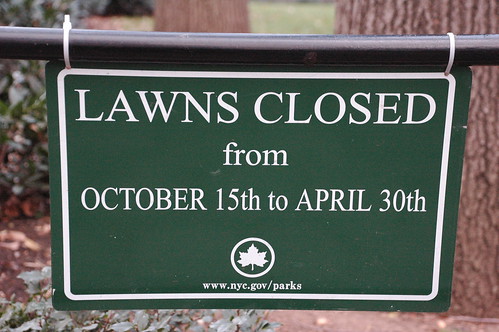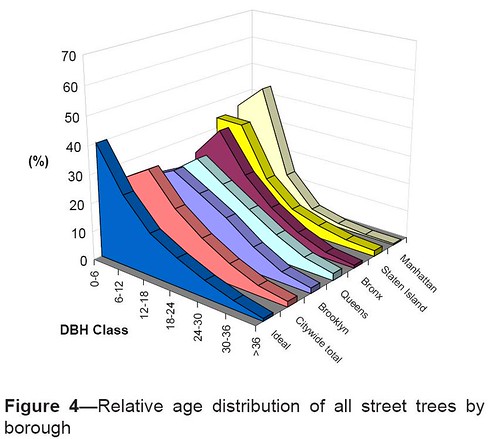Updated 2007.11.04: Added Community section.
Afternoon Morning Glory, East 4th Street Community Garden (Windsor Terrace Kensington Veterans Memorial Garden), Kensington, Brooklyn

This afternoon a couple of Flatbush neighbors and I visited the East 4th Street Community Garden. It occupies .184 acres at 179 East 4th Street, between Caton Avenue and Fort Hamilton Parkway in Kensington. It also serves the neighborhood of Windsor Terrace.
The dedicated local residents of the East Fourth Street Garden Association have tended this site, formerly known as the Windsor Terrace Kensington Veterans Memorial Garden, since they first organized it in 1979. The garden, incorporated in 1981, has come to serve a central role as a gathering place in this community. The East Fourth Street garden has funded its operations and special projects through dues collection, flea markets, and two Mollie Parnis Dress Up Your Neighborhood Awards.
– Parks Sign, East 4th Street Community Garden
The purpose of our visit was to meet with our gardening neighbors to the west, get ideas from their gardens, and learn from their experience.I arrived around 3pm, before anyone else showed up. That’s when I took most of these photos. I met one of the gardens, Mary Beth, who had brought her pumpkin for composting. We were then joined by two of my neighbors, Gary Jonas and Nelson Ryland. Michael O’Hara, who’s been with the garden for six years, arrived, then Susan Siegel.
Established on city property, the East Fourth Street Garden uses land originally cleared of homes for the construction of the F subway line in the 1930s. Transit builders changed their plans, running the line underground where the Windsor Terrace branch of the Public Library now stands. In 1998, the Department of Housing Preservation and Development (HPD) surrendered the Fourth Street garden between Fort Hamilton Parkway and Caton Avenue to Parks. This arrangement safeguards the garden’s status as a green space while leaving the administration largely in the hands of its community developers.
You can see the grates for the subway in the sidewalk in front of the garden. During our visit, we heard, and felt, the subway rumbling beneath us every few minutes. The future home for the Flatbush Community Garden is adjacent to the open-cut B/Q line; the sounds and sensations of subway trains will be frequent there, as well.

Individual Plots
Here’s a view from the rear of the garden, looking West toward the entrance and East 4th Street. The individual plots are in the center of the photo, extending off-frame to the right. I counted 26 plots.

Here’s a view from the North, from the shelter of the shady path which is one of the common areas in the garden.


The plots are edged with untreated, exterior-grade boards. These are concessions to decorum; as Michael explained, “Plots tend to expand.” Well-defined plot edges, like good fences, make good neighbors. They also keep the plants from spilling into the paths, which need to be mowed regularly, and keep people walking the paths from trampling the plants and plots.




Plot Signs

Common Areas
Common areas wrap the garden on its south, west, and north sides. Here are some views of the common areas along the front/street side of the garden.




One of the features which interested us today was the north side of the garden with several mature trees, including some old apple trees. The Flatbush site, with its forest of 50-year-old trees, has lots of shade. Here a path enjoys the shade from the trees, leading from the front to the rear of the garden, toward the compost area and pond.






Necessaries
I met Mary Beth, one of the gardeners, here by the composting area. She came by to contribute her spent Jack-o-lantern. She lives in an apartment in the area. She told me she “always loved the smell of dirt” growing up. She now has an individual plot in the garden.
Composting area

I thought the signs were a great way to encourage people to use the compost. They distinguish the finished product from that still in-process, and explicitly grant permission to people to use what they need.

Also important are clear signs detailing what can and can’t go into the compost.

Salvaging building materials for reuse in the garden is a way to keep costs down and keep construction and other building debris out of the waste stream.


There’s no free source of water for the garden. Their water bill runs about $400 a year. So collecting and storing rainwater is another sustainability practice that saves the garden money.


I want to build a bat house. Some of the Flatbush visitors wanted to know “where do you get the bats?” They didn’t know that bats are already native residents of Brooklyn, and “if you build it, they will come.”


Community
When we visited, the day was overcast and buffeted by winds from tropical storm Noel passing off-shore. We were there after the normal visiting hours, and the garden was empty except for the six of us. Michael told us that we would “have to come here on a busy day in the summer” to see the community in evidence in the garden.
According to Michael, the garden was “a well-kept secret for a long time.” Today there are about 60 people on the mailing list, and 20-30 active members, with a 1 year waiting list. Dues are about $20/year.
Members come from within a four or five block radius of the garden. Maintenance requires weekly visits over the summer, so geographic proximity is important. Members also need to sign up for shifts for shared responsibilities, such as seasonal cleanups and keeping the garden open to the public during scheduled hours. They encourage members who don’t yet have individual plots to plant and maintain containers, or sign-up for the numerous gardening tasks in the common areas. This gives them a feel for the time commitment it takes, especially important for those with little gardening experience.
The garden hosts the Kensington/Windsor Terrace CSA (Community-Supported Agriculture). This CSA is supplied by the Garden of Eve farm on the East End of Long Island. In a recent survey of CSA members, 100% of those responding said they were happy with the garden as a distribution site.
Links
Flickr photo set
East 4th Street Community Garden (OASIS page)
East 4th Street Community Garden (Parks page)
Kensington/Windsor Terrace CSA (Blog)
Garden of Eve
[where: 179 East 4th Street, Brooklyn, NY]

































